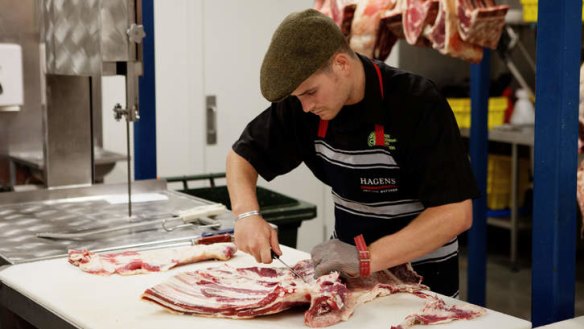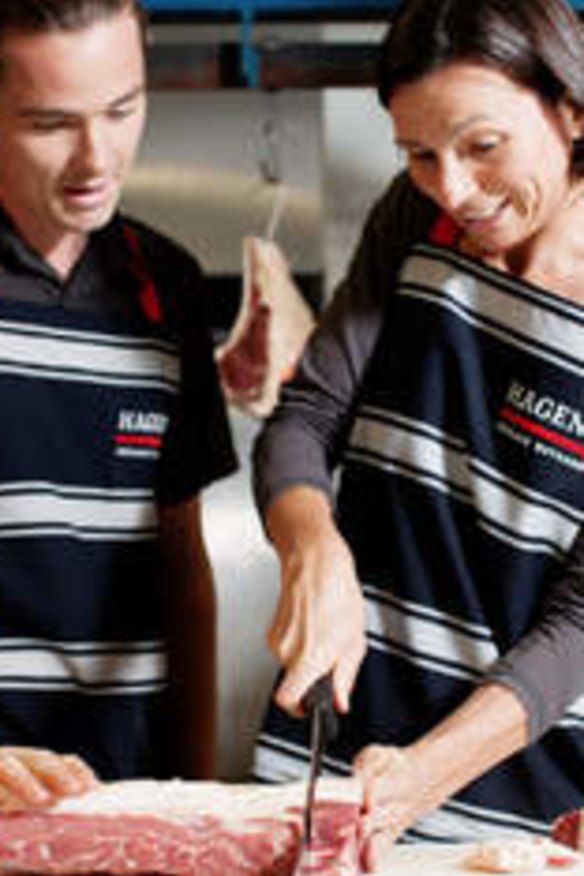Nose to tail
Meeting preconceptions about beasts head on.

To watch a man ''break a beast'' (or, cut up a cow) is to appreciate meat like never before. The appreciation is twofold. Firstly, it's a whole, hefty animal hanging there, with stumps where there used to be a head and legs. It's an animal, recently alive; it's not tidy piles of chops, steaks or sausages … yet. And that's the other awesome aspect, how a butcher sees through fat and flesh, navigating the anatomy of the animal by finding muscle fibres, connective tissue and bones, and, ultimately, each cut of beef.
I'm at Hagens' 18-month-old, gleaming stainless-steel butchery in Richmond for its first butchery class, run by Oliver Hagen and Scott Rogers.
The stabbing, ripping, slicing and sawing quickly become secondary to Rogers' skill. While my butchery classmates and I are still nibbling on complimentary slices of house-smoked ham, Rogers has already driven his knife into the beast and removed the flank. He's not a big man (not as big as a cow), and puts his whole body into those targeted and precise cuts. His hands are soft (incidentally moisturised from the daily handling of animal fat) and rarely still: either rapidly swiping his knife against a sharpening stone, or plumping or preening a cut of meat once he's dropped it onto the stainless steel bench.

While Rogers cuts, Hagen calls it: describing what Rogers is doing (maybe counting ribs), and why. The first six ribs are the best, he tells the class. Any further down are closer to the shoulder and tougher. It's part anatomy lesson, part cooking class. Once you understand from where the meat comes and its original function, it's easy to understand how it ought to be cooked. The shoulder, leg and neck, for example, do most of the work and are the toughest; they need a long, slow cook to dissolve the connective tissue into gelatin.
Hagen knows his meat; he's worked here since he was 13, with his dad, Royce, who started the business in 1999 and sold organic veg for years before that. Oliver is 24, and has been running Hagens since Royce died in December last year. "I've wanted to introduce butchery classes for ages," he says. "Finding Scotty, who worked at Marylebone, London's, Ginger Pig butcher - where classes are booked a few months ahead - meant we could get them off the ground."
Hagen's generous with his knowledge, throwing out facts on farming (including differences between breeds and raising practices), ageing meat, tips on how to use a knife (and gory stories illustrating how not to), as well as the perfect steak recipe.
As the hanging carcass becomes smaller and the piles of cuts grow to cover the length of three tables, it's apparent there are many more cuts of beef to cook with than the two or three in my repertoire. It's like a live action of Fergus Henderson's The Whole Beast: Nose to Tail Eating, for beef; it suddenly seems wasteful to not consider eating chuck or neck.
Hagens wastes nothing. All trim is tossed into one of three buckets; the various grades of trim used for everything from sausages to fertiliser. All meat is organic (except pork; pigs eat too much to make that possible, apparently, but they're free-range Berkshire), or uber-organic, raised biodynamically according to lunar cycles as outlined by Rudolf Steiner back in the '20s.
And now for the hands-on part of the evening where each class member gets to work on making a rolled ribeye to roast. This involves sawing (physical stuff, I broke into a sweat), trimming the bones, slicing off the fat and rolling it back on, then stringing it all together. Sounds easy … Hagen reckons that "anyone can cut up meat" (he says this before seeing me make a hack of it), "but to make meat look good and appetising, that's the art of butchery".
The evening ends at the All Nations pub next door with something they prepared earlier: two pink-centred, well-rested rib-eye roasts with all the trimmings and a pint of Collingwood Draught from Brunswick brewer Thunder Road. And it's here that I taste beef as if for the first time.
Hagens butchery classes run fortnightly. Next class: April 24; $275 (includes a cooler bag, carving knife, slash-proof glove, butcher's apron, take-home roast, and pub meal); 52 Lennox Street, Richmond, 9428 2471 hagensorganics.com.au
The best recipes from Australia's leading chefs straight to your inbox.
Sign up